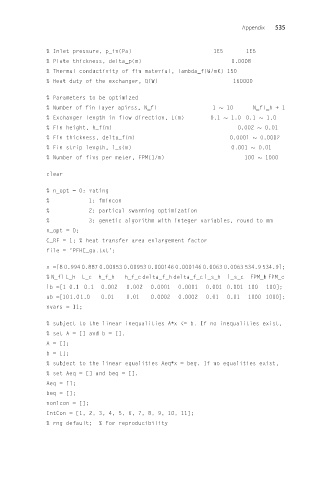Page 552 - Design and Operation of Heat Exchangers and their Networks
P. 552
Appendix 535
% Inlet pressure, p_in(Pa) 1E5 1E5
% Plate thickness, delta_p(m) 0.0008
% Thermal conductivity of fin material, lambda_f(W/mK) 150
% Heat duty of the exchanger, Q(W) 160000
% Parameters to be optimized
% Number of fin layer apirss, N_fl 1 10 N_fl_h + 1
% Exchanger length in flow direction, L(m) 0.1 1.0 0.1 1.0
% Fin height, h_f(m) 0.002 0.01
% Fin thickness, delta_f(m) 0.0001 0.0002
% Fin strip length, l_s(m) 0.001 0.01
% Number of fins per meter, FPM(1/m) 100 1000
clear
% n_opt = 0: rating
% 1: fmincon
% 2: partical swarming optimization
% 3: genetic algorithm with integer variables, round to mm
n_opt = 0;
C_RF = 1; % heat transfer area enlargement factor
file = 'PFHE_ga.txt';
x =[8 0.994 0.887 0.00953 0.00953 0.000146 0.000146 0.0063 0.0063 534.9 534.9];
% N_fl L_h L_c h_f_h h_f_c delta_f_h delta_f_c l_s_h l_s_c FPM_h FPM_c
lb =[1 0.1 0.1 0.002 0.002 0.0001 0.0001 0.001 0.001 100 100];
ub =[101.01.0 0.01 0.01 0.0002 0.0002 0.01 0.01 1000 1000];
nvars = 11;
% subject to the linear inequalities A∗x <= b. If no inequalities exist,
% set A = [] and b = [].
A = [];
b = [];
% subject to the linear equalities Aeq∗x = beq. If no equalities exist,
% set Aeq = [] and beq = [].
Aeq = [];
beq = [];
nonlcon = [];
IntCon = [1, 2, 3, 4, 5, 6, 7, 8, 9, 10, 11];
% rng default; % For reproducibility

